What a week, What an amount of unique experiences! Sitting in the train I think back at all the things we have done this week and I think I can say that I had a real Texel experience. I finally had my real Texel bear, survived biking through the storm, have seen the lighthouse and the beaches at the tip of the island. But the thing that I think I always will remember is the meat excursion Borris Caroline and I did.
Even though I'm a meat eater, I never have been so close to the way an animal is processed into meat on my plate . All though the farmer first link in the chain of meat, we started our excursion at the slaughter house. I had to take a deep breath to not get instantly nauseous of the things I saw. The smell in the slaughterhouse was really intense and blood was everywhere, even on the clothes of the Slaughter Cor Boschma. He gave us a tour through the building and told us how the animals are treated. It was really beautiful to see how he talked with so much respect for the animals. On to the next link in the chain, the butcher shop. But before I could step into the car I had wipe off the pieces of meat and blood that were stuck under my shoes.
At the butcher the lamb, that we saw earlier hanging on a hook at the slaughterhouse was living in the shelves waiting for someone who would want to buy it. For real Texel experience we bought a piece of lamb ham. With our hungry stomachs we tasted the meat. Eating this little piece of meat was really intense. I struggled to swallow it. It tasted exactly the smell of the slaughterhouse. I never expected that I would be so shocked by the taste of a little piece of meat. I realized, this is real live, this is the real business. However my meal was less tasty that evening.
To finish the whole experience we went to the place where the animal came from. The farm Werner Dros. The angry man earlier this week, turned out to be a concerned farmer who is very involved with the island. He talks full of respect for his animals. With beautiful statements like, “you never should walk like an elephant through a porcelain cabinet” and “As a farmer, you have to keep your pants up yourself” he explained a lot to us about the meat cycle on Texel.
A few weeks ago, I wrote a column about meat and its ecological footprint. To eat meat in a sustainable way, the amount we eat really needs to decrease. I think this meat excursion will help me to achieve this goal. It was wonderful to see how the whole meat circle on Texel treated the animals with such a respect, but it is good to know that it is not always done like this. And in order to get this kind of meat you have to pay for it. I think I will leave the kilos stunner next time and maybe go to the butcher for a better piece of meat. Where will the piece of meat from the butcher in Delft actually come?


